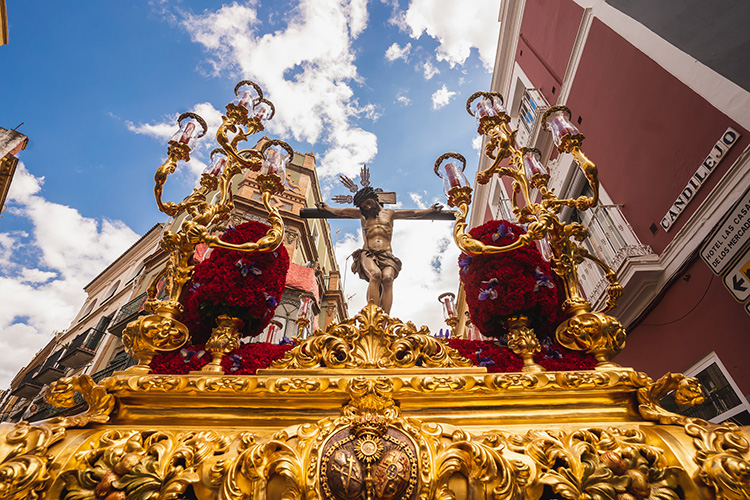In the early days of spring each year, Easter celebrations around the world welcome the arrival of new growth in remarkably creative and diverse ways.
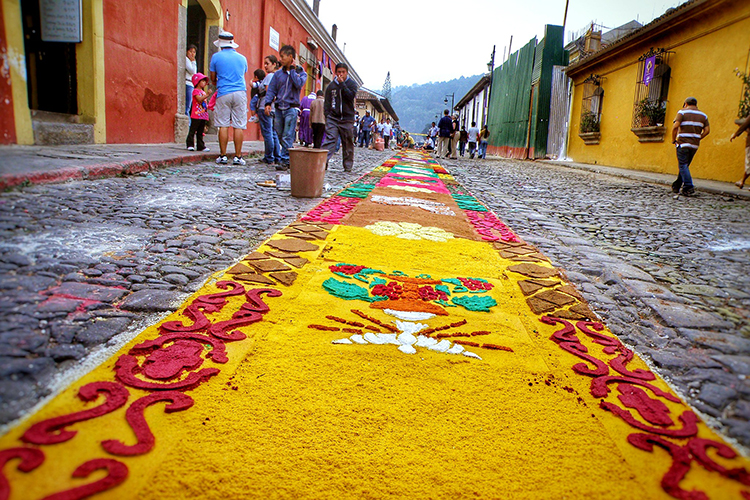
A beautiful alfombra in Antigua (Photo: Dennis Sylvester Hurd via Flickr / CC0 1.0)
It’s that time of year again when the woodlands and fields fill with fuzzy baby animals and you anticipate having a chocolate-induced hangover at least once. Easter’s roots connect to pre-Christian rituals and beliefs, which welcomed the springtime renewal and rebirth being witnessed in nature. In the West today, festivities are predominantly Christian and celebrate how Jesus’ Resurrection completely freaked everybody out. And every so often, thanks to religious fervour, relief at the end of winter, or simply the relentless creativity of the human spirit, certain peoples around the world decided to do something a little different for Easter.
To avoid exclusively featuring celebrations of the Christian faith on this list – despite many being understandably linked in some way – we decided to set a few rules: Each celebration or festival needed to be unique in some way. Events also need to be confined to one town, village or city, rather than a broader national holiday or religious festival. Or at least do what everybody else is doing with a unique twist. Each entry also needed to have a strong historic link to the past. And, with one exception (because Spain is good at Easter), we limited entries to one per country. Without further ado, in alphabetical order by country, here are the world’s most unique Easter and Easter-adjacent festivals.
Good Friday KiteFest, Bermuda
Easter celebrations don’t get lost in the Bermuda Triangle. In fact, on good Friday, the island nation enjoys one of the jollier manifestations of this springtime festival, kissing the sky with thousands of colourful kites. Bermudians make their own kites out of bamboo, wood and tissue paper. Some are simple, some elaborate, and many have long tails to help the kite stay up in the air. But one thing that the kites share in common is a cross-shaped central structure, which is said to be a nod to KiteFest’s origins, when a teacher demonstrated with a kite how Jesus ascended to heaven after his crucifixion. The event, run by the Chewstick Foundation, includes awards for the best kites in a number of categories.
Knights of the Giant Omelette, Bessières, France
The Knights of the Giant Omelette (also known as the Brotherhood, like something from a Terry Pratchett novel) spearhead the commendable French effort to ensure that good food is placed front and centre at any unique Easter celebration. Citizens of Bessières, a town that lies 30km (19 miles) northeast of Toulouse, are said to have made the original giant omelette for the hungry soldiers of Napoleon’s army, who were stationed nearby. Suffice to say, it went down so well that the town now makes one every year. Chickens beware! Recent counts suggest 15,000 fresh eggs and six kilos of seasoning are used each time. It takes a crane to lower a pan giant enough to accommodate a giant omelette into place, along with wooden spoons as big as oars. Alongside the omelette, dozens of 1.5-metre-long baguettes are also baked.
The Georgiritt, Traunstein, Germany
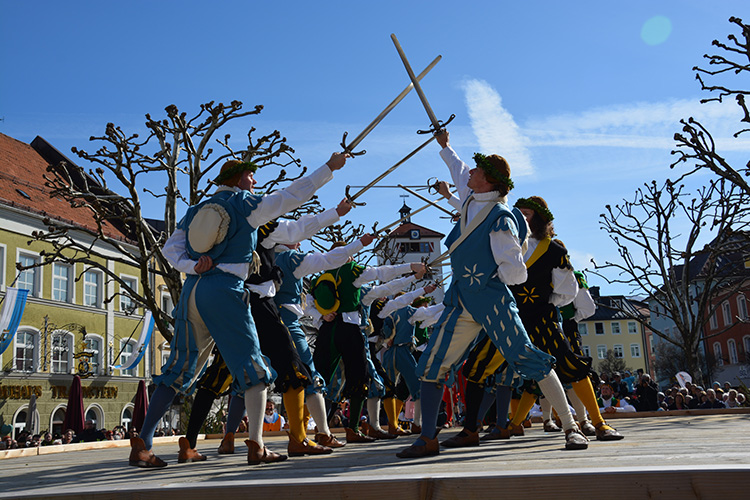
The sword dance at the Georgiritt (Photo: courtesy Große Kreisstadt Traunstein)
Not only is St George the patron saint of England, Georgia, Ethiopia and many other world regions, he also features heavily in various traditions. In the Bavarian town of Traunstein, the Georgiritt – a large horse pilgrimage on Easter Monday – commemorates his legendary dragon slaying. Horses are decorated with plaited manes and tails, and bedecked with flowers, plants and ribbons. Some pull carriages. Riders don traditional rural clothing and there’s even a St George, suited in armour, with a shield and sword. The day begins with a schwertertanz, or sword dance, symbolising the victory of spring over winter. The procession, backed by the gaiety of a Bavarian oompah band, then loops around Ettendorfer Church and culminates in blessings of the farm animals for the year ahead.
Rouketopolemos, Chios, Greece
On the Greek island of Chios, Panaghia Ereithiani and Angios Marcos are two churches that break the peace and tranquillity once a year. It seems like an unusual thing for a church to do, let alone two churches, but shooting fireworks at your neighbour is the aim of Rouketopolemos every Easter. The rival parishes take aim at one another’s belfries in a rocket war that takes place as the midnight liturgies (marking Orthodox Easter, which still follows the Julian calendar) in either church are held. To make things even more hectic, many rockets are homemade contraptions using a gunpowder-based propellant. A valley separates the rivals by 230m (755 feet). But it could be worse, in the past, canons were rumoured to have been used instead.
Colourful Carpets, Antigua, Guatemala
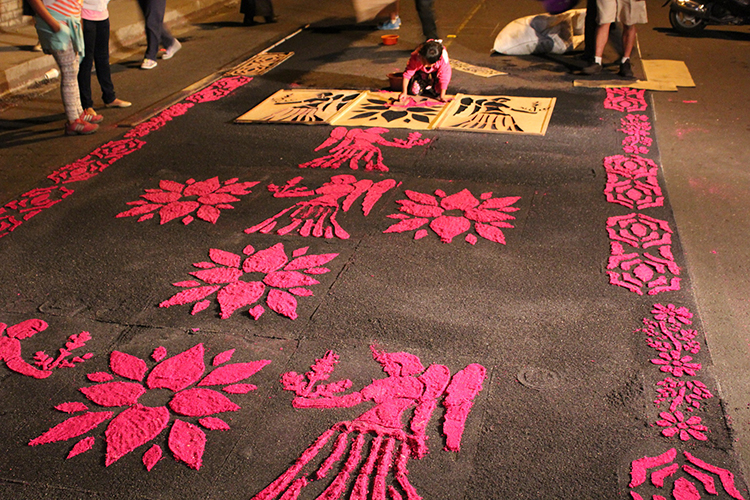
Making the alfombra in Antigua (Photo: Arian Zwegers via Flickr / CC BY 2.0)
The award for the world’s prettiest parade route must undoubtedly go to Guatemala’s Antigua, for the historic city’s semana santa parade route artworks. These alfombras (carpets), as they’re known, take many hours and hundreds of volunteers to create using stencils and sawdust of varying colours. Work begins on Thursday evening and painstaking detail is put into creating intricate patterns made up of flowers, fruit, sawdust, pine needles and vegetables on a sand foundation, all emanating a pleasant aroma. By Good Friday morning they form bold, vibrant meshes of traditional designs, floral motifs and religious iconography that will be largely destroyed by the next morning, as a result of the processions walking right over them. The destruction of nice things is supposedly a nod towards the sacrifice Jesus made to unite his followers with God.
Sprinkling, Hollókő, Hungary
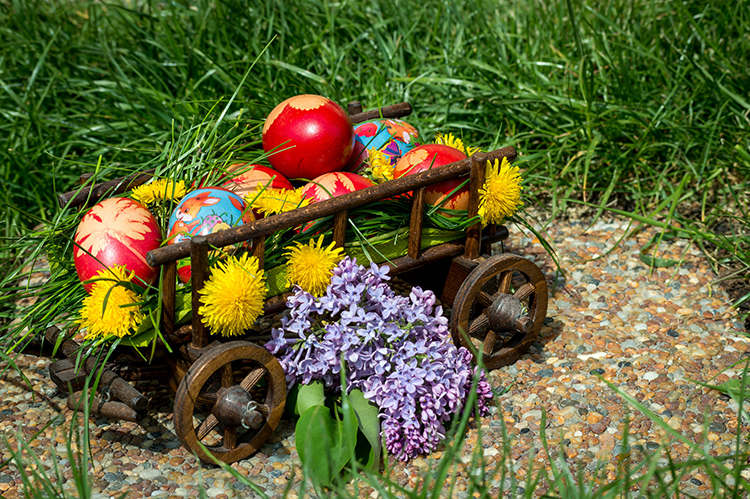
Traditional Easter presentation in Hungary (Photo: Tamas Kiss via Flickr / CC0 1.0)
Across much of Eastern Europe, Easter is a time when women pre-emptively wear waterproof clothing. Or at least they should, for various forms of mildly irritating water-based iniquity are afoot. Known as smigus-dyngus in Poland, with similar events in Romania and Slovakia, it generally consists of men running around, throwing buckets of water over the womenfolk. It is, of course, willingly participated for the most part, with traditional costumes worn and rustic wooden buckets used for good measure. In Hungary’s Hollókő village, what is locally called Locsolkodás was upgraded so that instead of throwing buckets of water, smaller amounts are ‘sprinkled’ instead. In what seems like an unfair trade, by tradition, the women reciprocate by handing their assailants a shot of palinka (a local fruit brandy).
The OG Easter Sites, Jerusalem, Israel
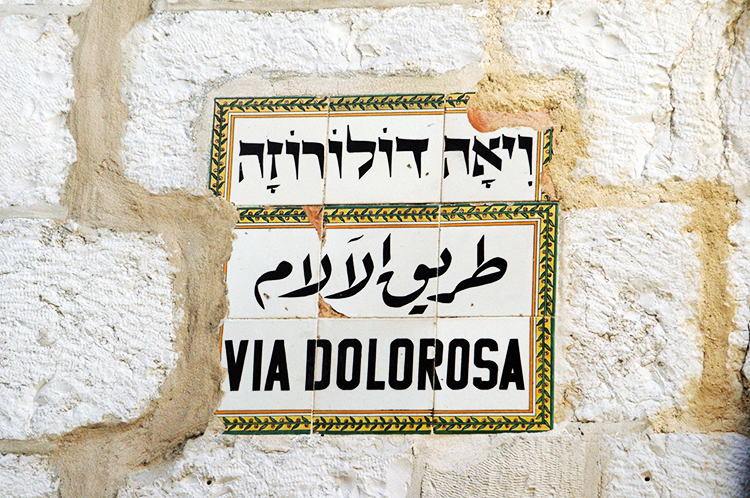
Jerusalem’s Via Dolorosa (Photo: Maureen via Flickr / CC BY 2.0)
Perhaps the most authentic Easter trip for Christians to take is a pilgrimage to Jerusalem, to visit the sites where the Biblical events, around which the Easter celebration is framed, are said to have taken place. On Holy Thursday many visit Mount Zion, where the Last Supper is said to have taken place. Being at a complicated and contentious crossroads of many faiths, as Israel is, some suggest that that final meal was eaten to mark Passover, the Jewish holiday celebrated at around the same time, to honour the Israelites’ escape from Egyptian slavery. On Good Friday, people follow the Via Dolorosa to the Church of the Holy Sepulchre (where Jesus is believed to have been buried and Resurrected), a sombre, yet devout following of Jesus’ last steps. Other major sites include an Easter Sunday prayer service at the Garden Tomb, an alternate site where some say Jesus was buried. The Garden of Gethsemane and the Mount of Olives are among the other highlights.
Scoppio del Carro, Florence, Italy
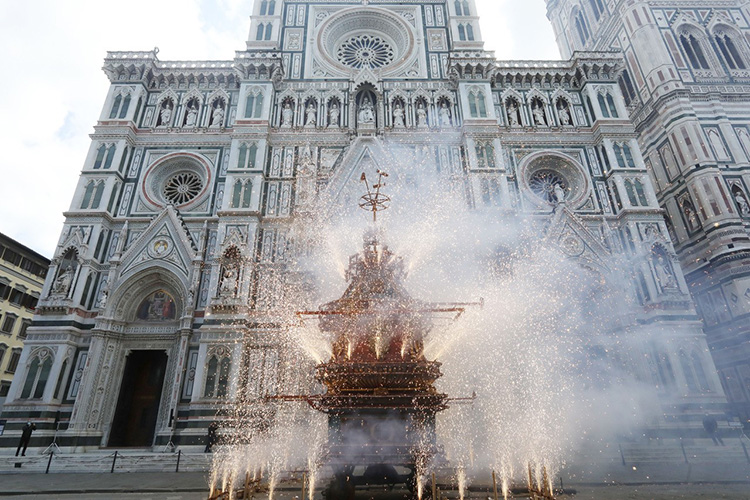
Scoppio del Carro (Photo: courtesy Municipality of Florence)
Fireworks are a chaotic and gleeful manifestation of Europe’s old springtime fire rituals. Nowhere does it quite so uniquely as Florence. The Explosion of the Cart (or Scoppio del Carro) is precisely what it sounds like. Every Easter Sunday, oxen, adorned in bright floral headdresses pull a cart, made in the 18th century, into the Piazza del Duomo, Florence’s main city square. That’s where the real extravagance begins. After giving Easter Mass, the archbishop sends a mechanical dove down a wire, stretching from the Duomo’s altar to the cart, igniting a chaos of fireworks. It’s a tradition linked to the First Crusade in 1099, when a young Florentine from the noble Pazzi family was supposedly the first to scale the walls of Jerusalem.
Kanamara Matsuri, Kawasaki, Japan
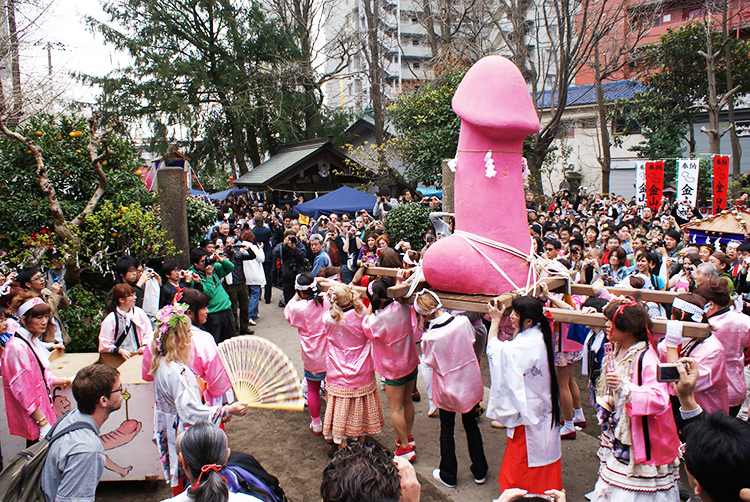
Japan’s Penis Festival celebrates fertility (Photo: Takanori via Flickr / CC BY 2.0)
As far as festival names go, the Festival of the Steel Phallus, aka Kanamara Matsuri, is about as on the nose as it gets. This celebration of fertility, and a favourite with the LGBTQ+ crowd, has adopted giant penises as the primal core around which a giant street party is wrapped. And while that might sound like a wryly modern type of thing to do, its origins lie historically in the country’s Shinto religion. The parade, usually on the first Sunday in April, takes place at the Kanayama Shrine in Kawasaki, to the south of Tokyo. Here, worshippers have historically asked the gods – Kanayama-hime and Kanayama-hiko – for success in marriage and childbirth, and for protection against STDs. The event involves a lot of knobs, schlongs, willies and fancy dress related to such appendages, leaving little doubt about the true source of this festival’s popularity.
The Passion Play, Iztapalapa, Mexico
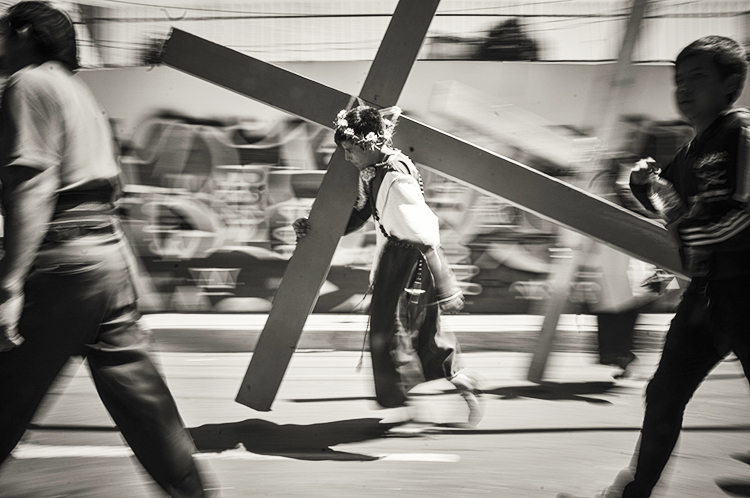
Iztapalapa’s passion play (Photo: Eneas De Troya via Flickr / CC BY 2.0)
As Spain’s conquistadores plundered lands far and wide for the reyes back home, they also enforced Christianity and their own brand of worship onto those regions. Today, the New World brand of Catholicism is perhaps the most devout. In Mexico City’s Iztapalapa, an outlying borough of Mexico City, the crucifixion of Christ takes centre stage. La Pasión, as it is known, involves thousands of penitent locals known as nazarenos, many of whom are actors hired for the event, who walk through the streets dragging crosses behind them. Men, women and children all take part, some walking barefoot through the streets. They all head to a hill, where three lucky penitents are hung from crosses.
PaasVuur, Espelo, Netherlands
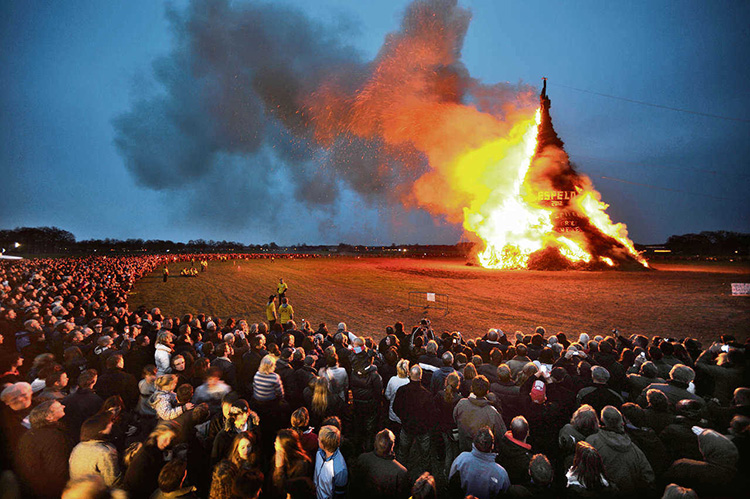
Espelo’s world record hand-built bonfire (Photo: courtesy Paasvuur Espelo)
Fire holds an important symbolic role in the springtime celebrations of many countries around the world, as the atmosphere warms and the actual need for fires to stay alive during the freezing weather declines. Across Germanic lands, Easter fires have been held to celebrate the arrival of spring. The Netherlands town of Espelo’s fires are rumoured to be among the very best. The tiny hamlet holds the world record for the largest hand-built bonfire. Known as the PaasVuur, the hamlet’s effort in 2012 reached almost 46m (151 feet) tall. Materials are sourced responsibly in conjunction with local conservation and forestry officials, with youths from the area taught how to build a safe structure by the elders. As with much of western Europe, the religious significance has faded from the event, but the whimsy remains.
Maleldo, San Fernando, Philippines
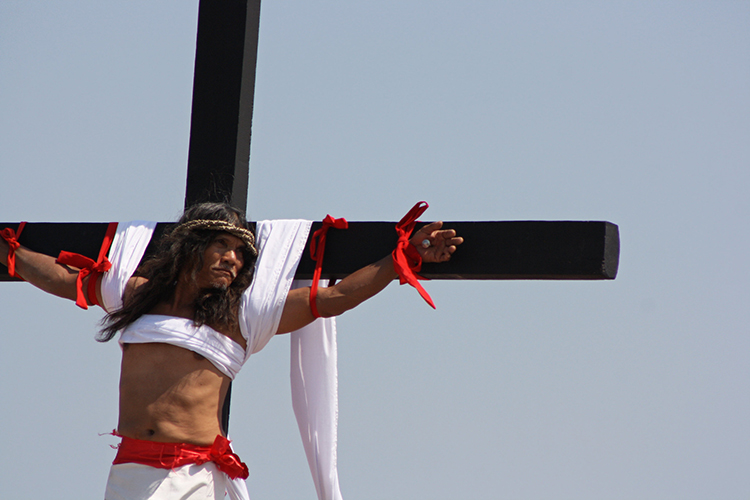
Ruben Enaje on the cross (Photo: istolethetv via Flickr / CC BY 2.0)
Similar to the Mexican approach, an even bloodier degree of devotion accompanies the Easter (known as maleldo) crucifixion re-enactment in San Fernando, north of Manila in the Philippines. While there’s pageantry – people dress up as Roman guards and various Biblical characters – this is primarily about hard penance. Penitents (aka magdarame) walk barefoot or crawl through the streets, some self-flagellating with bamboo sticks until their backs are raw and scarlet with blood. This all happens on the way to a makeshift Calvary, where the especially repentant participants are hammered to a wooden cross with thick nails that have been soaked in alcohol and left to hang there in front of the spectators for around ten minutes. It’s worth noting that the Catholic church of today discourages the practice. Local painter, Ruben Enaje, is the most famous magdarame, racking up 33 crucifixions! Will 2023 be his 34th?
Easter at the Salt Chapel, Kraków, Poland
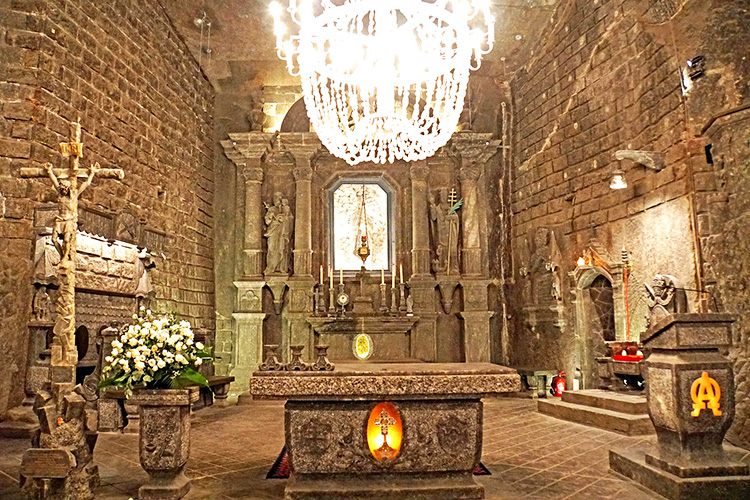
St Kinga’s Chapel in Wieliczka Salt Mine (Photo: Dennis Jarvis via Flickr / CC BY-SA 2.0)
Wieliczka Salt Mine could easily be something from a fantasy novel. Between the 13th century and 2007, table salt used around Europe came from this hole in the Polish ground. Those centuries of mining created a large number of chambers, some of which contain salt lakes, while others were converted into chapels, such as the Chapel of St Kinga. Lying around 100m below ground, St Kinga is 12m high, with resplendent, flowing chandeliers and an altarpiece carved from the rock salt. Elsewhere, a version of Leonardo’s The Last Supper is carved into a wall. The mass held here during Easter is certainly one of the few known to take place below ground. Occasionally, there’s also a Holy Saturday concert in the Chapel of St Kinga by the Wieliczka Salt Mine National Orchestra.
Semana Santa, Sevilla, Spain
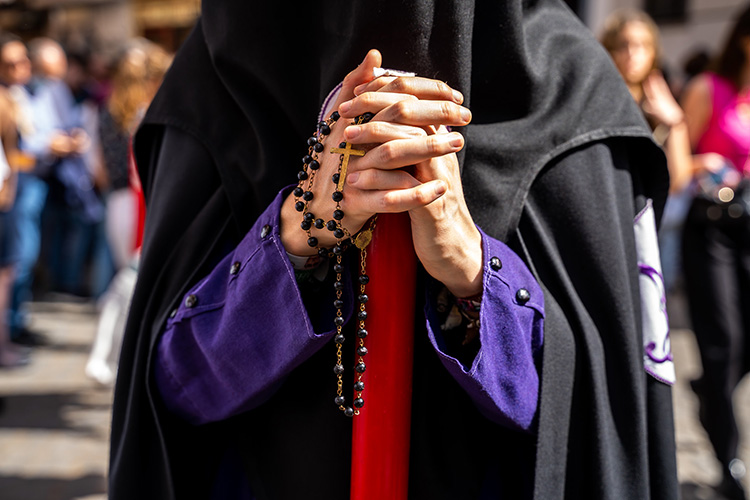
Penitence in Sevilla (Photo: courtesy Sevilla City Office)
Nobody observes Easter with such rigour as the Spanish. From the largest cities to the smallest villages, semana santa is a big deal, where Catholic confraternities (cofradías), also known as brotherhoods, engage in multi-day parades through the streets, wearing pointed-hood cloaks and carrying floats heaving with a baroque assemblage of flowers, effigies, candles and statues of Jesus and Mary. These events take on a beefier scale and grandeur in the cathedral towns, such as Zaragoza and Toledo, but none are quite so unique as those of Sevilla, where dozens of parades are undertaken by almost 50,000 cofradía members. But what gives parades a unique edge are the saetas, deeply emotive flamenco songs sung by vocalists, standing on balconies, at the processions below.
Roman Passion, Tarragona, Spain

Romans in Tarragona (Photo: Manel Antolí, courtesy Tarragona Local Tourism Board)
Entries from Spain could arguably pad out this entire list. But the procession in Tarragona, in southern Catalonia, although often overlooked for its smaller scale, has a unique twist: it also includes a celebration of the city’s Roman heritage, which neatly interlinks with the story of Jesus’s ultimate sacrifice. Overlooking the Mediterranean, Tarragona’s Part Alta was formerly one of Ancient Rome’s key settlements on the Iberian peninsula. On Good Friday, as the sun is setting, the sound of heavy footfalls, accompanied by drums, marks the arrival of the Roman armats (soldiers) who proceed to weave from one church to the next, slowly adding parishioners carrying torches or their church’s float to the tail of the ever-growing procession.
Festival Pysanka, Kolomyia, Ukraine
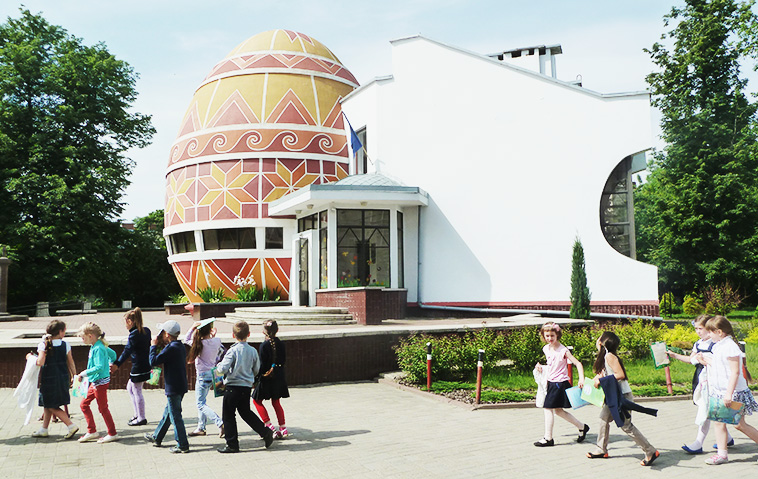
Children about to visit the Pysanka Museum (Photo: Paul Stafford)
Few items are more symbolic of Easter than the humble egg. It signifies the key springtime themes of fertility, birth and transition, as well as being a key source of food. At Easter, eggs are often made of chocolate or filled some devilish and irresistible type of sugar ‘cream’. But in Ukraine, wooden eggs – called pysanky – are decorated with traditional folk designs, a practice that is believed to date back to pagan times. This pastime is practiced across the Slavic world, but in the western Ukrainian town of Kolomyia, the artform is elevated to a whole new level. Outside of wartime, Festival Pysanka sees people come together to decorate their own pysanka and to visit the Pysanka Museum, whose multi-storey egg building is the largest egg in the world. Within, there’s a valuable collection of historic pysanky, including the country’s oldest from the 15th century.
Bottle-Kicking, Hallaton, United Kingdom
With its thatched-roof cottages and historic country pubs, Hallaton is the quintessential sleepy English village. Until Easter Monday, when a very peculiar sporting custom pits neighbours into fierce, brawling adversaries. This bizarre emanation of encouraged hooliganism started with an act of charity, when two ladies from Hallaton donated land to the church, giving thanks to God for sending a hare to distract a bull who was charging at them. Although they should have thanked the hare, the hare is traditionally baked into a pie each year by the local vicar and thrown to the poor, scrambling villagers along with three small kegs of ale. When one of these kegs, known colloquially as ‘bottles,’ was stolen by villagers from nearby Medbourne, the bottle-kicking event was born. Each year, participants from both villages wrestle, scrum and scrap over the “bottles”, attempting to get them over their opponent’s goal line. The best of three is the winner. Bonkers.
Easter Fires, Fredericksburg, Texas, USA
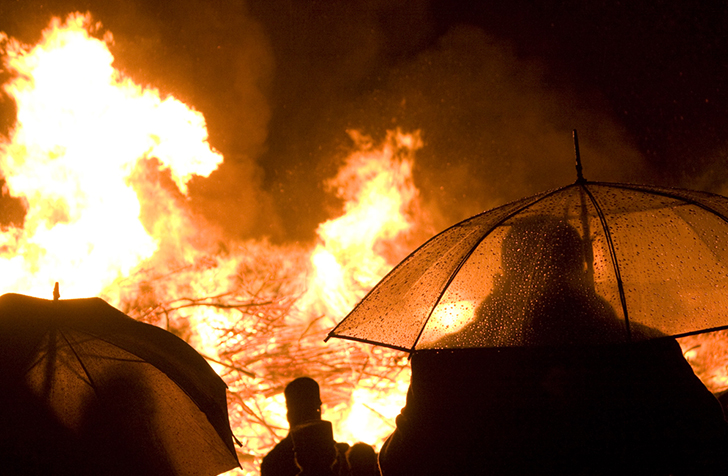
An Easter fire on a rainy spring night (Photo: Patrick Goossens via Flickr / CC BY-SA 2.0)
Given the Germanic tradition of Easter fires, it is unsurprising that many Germanic colonial settlers brought the custom across the Atlantic with them. Fredericksburg, the centre of Texan wine country, retains a particularly strong connection to its colonial past, including hosting its own Easter Fires festival every five years. And they come with a unique twist. When the church bells toll on the Saturday evening before Easter, twenty two separate fires are lit atop the hills around the town, surrounding Fredericksburg with flame. But rather than being fearsome, the fires are lit in the name of a peace pact signed between colonialists and the Native Comanche people in 1847. As those negotiations were being carried out, the Comanche scouts lit signal fires to communicate with their chiefs. This kinship with an Easter fire custom from back home in Germany led to the practice becoming ingrained as custom to mark the detente.
Way of the Cross, Vatican City
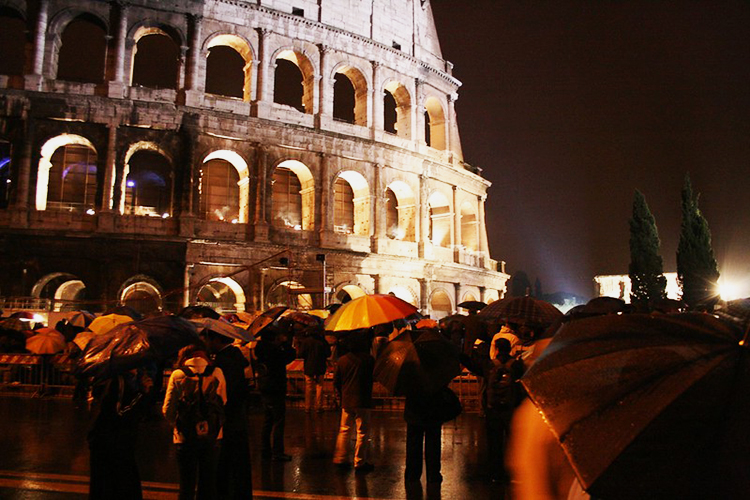
Braving the Rome rain for Way of the Cross (Photo: Ratio Partners via Flickr / CC BY 2.0)
For devout followers of Catholicism, there is no greater way to spend Good Friday than the Via Crucis (Way of the Cross) ceremony, headed by the Pope in Rome. Starting in an empty Colosseum, with everybody else crowded around the outside of the building holding candles, the Pope leads his followers through a liturgy. He then leads everybody on a torchlight procession to the top of Palatine Hill. The route simulates the route Jesus walked on the way to his crucifixion. Fourteen stops along the way recall different events during this death march. On Saturday (Holy Saturday as it’s known here), across the Tiber at St Peter’s Basilica in the Vatican, the Easter Mass is the main, extremely crowded event, although tickets are, understandably, tricky to come by. Expect to be elbowed in the ribs by an over-zealous nun.
Shimunenga, Maala, Zambia
Every good list needs an outlier. In the southern hemisphere, spring arrives between September and October each year. Although that is not aligned with Easter, celebrations of the end of winter and the arrival of spring or, in the case of countries closer to the Equator, the end of the dry season, are just as important and worthy of being here. Among the most unique is a traditional, tribal gathering in Zambia known as Shimunenga. Primarily celebrated by the Ba Ila people, it is an opportunity to feast, sing, dance and drink. The village of Maala is where an ancestral great warrior, Shimunenga, is believed to be buried. The main event is a cattle drive and spear charge past the ceremonial site to appease Shimunenga ahead of the rainy season. In recent years, Zambia’s leadership has emphasised the event’s importance in learning from and embracing Zambia’s cultural diversity.
Notable mention
Nowruz Buzkashi, Bamyan, Afghanistan
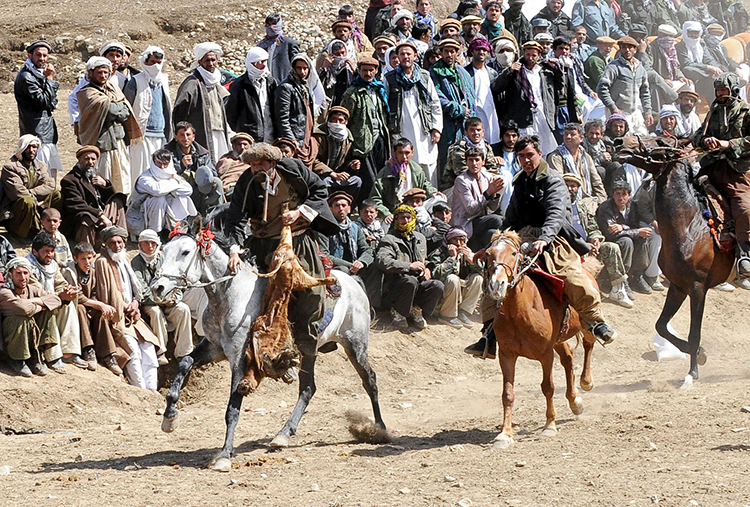
Buzkashi match in full flow (Photo: ResoluteSupportMedia via Flickr / CC BY 2.0)
Across Central Asia and the Middle East the festival to mark the beginning of spring is known as Nowruz. With roots in the fascinating religion of Zoroastrianism, which emanated from ancient Persia, Nowruz has a wide remit with some unique celebrations in Bamyan, central Afghanistan. Despite the historic roots of Nowruz, the Taliban are not receptive to anything that isn’t within their strictly limited purview of control and faith. While the event may well be forced underground under the current regime, celebrations at Bamyan, site of the giant Buddha statues so callously destroyed by the Taliban, can be seen as an act of quiet defiance. In freer times, locals flood the bare, rocky hillsides outside Bamyan to take part in huge tug of war competitions and watch buzkashi matches. The Afghan national sport takes after the horse-and-posh-person game of polo, albeit with the headless body of a goat in place of a ball.
